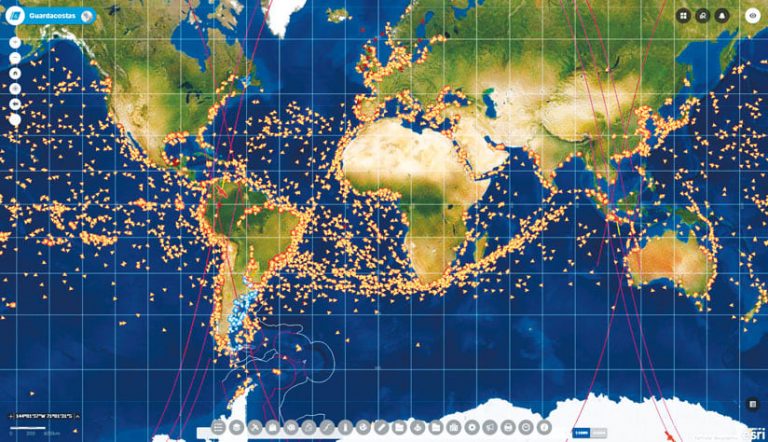Coast Guard Uses ArcGIS Enterprise to Monitor Illegal Activity on Country’s Ocean, Rivers
The Argentine Coast Guard, Prefectura Naval Argentina, oversees almost 1.4 million square nautical miles (1.8 million square miles) of water within Argentina’s exclusive economic zone (EEZ), which extends 200 nautical miles from the coast and covers more than 2,300 miles of inland waterways. On the open ocean, where Argentina’s EEZ adjoins international waters, illegal fishing is often a problem. Moreover, portions of the country’s aqueous areas traverse lush subtropical forests, making them prime routes for drug smuggling and human trafficking.
The coast guard deploys ships, helicopters, and observer planes to protect the EEZ against illicit activities. But as recently as five years ago, Prefectura Naval faced an uphill battle in monitoring marine poaching and trafficking.
“We had very little information about the use of our seas,” said Ernesto Miguel Klocker, director of informatics and communications for Prefectura Naval.
To collect more data about Argentina’s waterways and streamline how it monitors marine activity, Prefectura Naval began working with Aeroterra S.A., Esri’s official distributor in Argentina, to implement a real-time tracking system. Called Guardacostas, it consists primarily of ArcGIS Enterprise and ArcGIS GeoEvent Server, with analysis capabilities provided by ArcGIS GeoAnalytics Server and ArcGIS Insights.
Now, the Argentine Coast Guard can track and analyze patrols digitally, in real time, which has improved decision-making.
A Slow, Time-Consuming Process
Prior to implementing ArcGIS technology, the coast guard enforced maritime law by constantly patrolling waterways and investigating specific ships to get an idea of their background, including what they transport and if they’ve ever been involved in illegal activities before. It was especially important for the coast guard to monitor the porous 2,800-mile border of the EEZ, where boats would frequently attempt to sneak into the zone to poach fish or conduct other illegal activities.

The only way for the coast guard to get evidence of illicit incidents, however, was for a patrol vessel to visually confirm that a ship was doing something illegal, track it down, and then secure it. The process was limited by the number of ships Prefectura Naval had patrolling the EEZ, as well as their 25-mile radar range.
What’s more, Prefectura Naval stored the data it did have on ships in multiple isolated systems, so members of the coast guard could only see bits and pieces of information at one time. Getting a complete picture of a specific vessel required working with different systems and having an analyst create a background report on the ship that, if warranted, the coast guard could use to charge the vessel with a crime.
Whether dealing with illegal fishing in the Atlantic Ocean or smuggling on other major waterways like the Paraná River or the La Plata estuary, accurately identifying and tracking illegal activity was a slow, time-consuming process.
Big Data Made Manageable
Vessels involved in illegal activity don’t typically transmit their positions via the automatic identification system (AIS), an onboard transponder that broadcasts ship locations. The real-time system that Prefectura Naval and Aeroterra S.A. developed uses ArcGIS GeoEvent Server to monitor every significant vessel in the world and alerts the coast guard immediately when a boat encroaches on Argentine waters. By setting parameters and using signal processing and radar images, Prefectura Naval’s mission control can track a ship’s position both inside and outside the EEZ in real time, as well as detect ships that are not transmitting their positions.
Using GeoEvent Server, Prefectura Naval ingests and manages AIS data feeds, filters that data to find events of interest (e.g., a ship that enters a defined area, or a geofence), and configures alerts to send to mission control. ArcGIS GeoAnalytics Server conducts deep analysis on the huge amounts of data collected and, paired with ArcGIS Insights, allows mission control to see trends and patterns. The entire process is automated, so Prefectura Naval no longer has to rely solely on visual ship sightings to apprehend vessels that are engaging in illicit activities.
The Guardacostas system also enables Prefectura Naval to consolidate the data it used to house in various systems and combine it with geographic information, creating a common operating picture of what’s happening in the EEZ. This allows coast guard members to track more vessels with more data than ever before, resulting in keen situational awareness.
Light-Years Ahead
Having started with just 3 million records taken from about 20 AIS data feeds, Prefectura Naval’s database has grown to more than 17 billion records coming in from 50 feeds. ArcGIS GeoEvent Server now allows the coast guard to process 1,000 records per second and analyze them in real time. Compared to the manual, visual-based system it used before, this is light-years ahead.
The success of Guardacostas has encouraged the Ministry of Security, which the coast guard is part of, to adopt it more widely. Prefectura Naval is helping to roll out Esri technology in other groups, such as the federal police, airport security, and the national guard. These other agencies now use ArcGIS Enterprise and GeoEvent Server as well to track their own assets through mobile devices, radios, and other equipment with location sensors.
Prefectura Naval is also using ArcGIS Enterprise Sites to share different views of its data with other security forces. This is helping additional departments in the Ministry of Security get a better understanding of Prefectura Naval’s data, and some are even using it to improve their own deployments of field personnel.
From a technical standpoint, it was very challenging for Prefectura Naval to gather all the information it had available in different systems and use it effectively to combat illicit dealings in the EEZ. Since implementing the ArcGIS platform, however, the coast guard has turned this into a real-time operation, where information is received, processed, displayed, and archived instantly. Now, all that data is readily available and can be used to conduct better analysis and, ultimately, improve security.

